The Cost-Saving Potential of Commercial RO Plants
As freshwater becomes scarce and polluted industries turn to advanced water treatment. Commercial RO plants offer a popular solution. These plants can save businesses money across many sectors.
What is Reverse Osmosis?
Reverse Osmosis purifies water using a semi-permeable membrane. It removes ions molecules and larger particles from water. Pressure forces water through the membrane. Contaminants stay behind. The result? Clean purified water ready for various uses.
How RO Plants Work?
RO plants use several parts to purify water:
1. Pretreatment system
2. High-pressure pump
3. RO membrane
4. Post-treatment system
Water enters the pretreatment system first. This removes larger particles and protects the RO membrane. Next the high-pressure pump pushes water through the membrane. The membrane separates contaminants. Finally post-treatment adjusts the waters pH and adds minerals if needed.
Cost-Saving Benefits of Commercial RO Plants
Commercial RO plants can save businesses a lot of money. Lets explore where these savings come from.
Reduced Water Consumption
RO plants recycle and reuse water. This cuts overall water use. Industries that use lots of water like manufacturing or food processing can save big on water bills.
Lower Energy Costs
RO plants need energy to run. But they can actually save energy in the long run. This is especially true for industries that used to rely on energy-hungry water treatment methods.
Energy Efficiency Improvements
New RO plants use energy recovery devices. These capture and reuse energy from the high-pressure concentrate stream. This can cut energy use by up to 60% compared to older systems.
Decreased Chemical Usage
Old water treatment methods often use lots of chemicals. RO plants need fewer chemicals. This saves money and helps the environment.
Environmental Impact
Using fewer chemicals doesn't just save money. It also reduces the environmental impact of water treatment. This can improve a company's image and maybe even lead to tax benefits.
Maintenance Cost Reduction
RO plants need maintenance. But they often cost less to maintain than old water treatment systems. They have simpler designs and fewer moving parts.
Predictive Maintenance
New RO plants have advanced monitoring systems. These allow for predictive maintenance. This prevents surprise breakdowns and cuts overall maintenance costs.
Industries Benefiting from Commercial RO Plants
Many industries can benefit from commercial RO plants. Lets look at some examples.
Food and Beverage Industry
Food and beverage makers need clean water. RO plants ensure consistent water quality. This improves product quality and cuts production costs.
Brewery Example
A craft brewery started using an RO plant. They cut water use by 25%. This saved money and made their beer quality more consistent.
Pharmaceutical Industry
Drug makers need very pure water. RO plants provide ultra-pure water that meets tough industry standards.
Power Generation
Power plants need lots of pure water for cooling and making steam. RO plants can cut water and chemical costs a lot in this industry.
Cooling Tower Efficiency
A power station put an RO plant in their cooling tower system. They cut blowdown water by 40% and chemical use by 50%.
Conclusion
Commercial RO plants can save businesses a lot of money across many industries. They cut water and energy use, need fewer chemicals, and cost less to maintain. While setting them up needs careful thought, the long-term savings and environmental benefits make RO plants attractive for many businesses.
As water becomes scarcer and environmental concerns grow, efficient water treatment will become more important. Commercial RO plants offer a cost-effective and sustainable solution for businesses water needs.
To explore customised commercial RO plants, Industrial RO plants, ETP or STP solutions for your needs in your areas and nearby regions, contact Netsol Water at:
Phone: +91-965-060-8473, Email: enquiry@netsolwater.com



